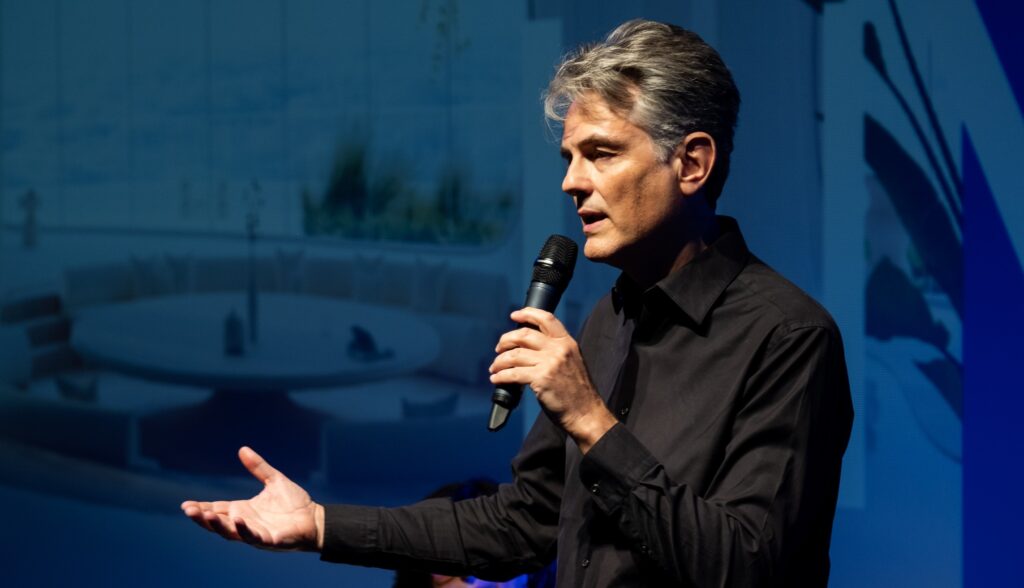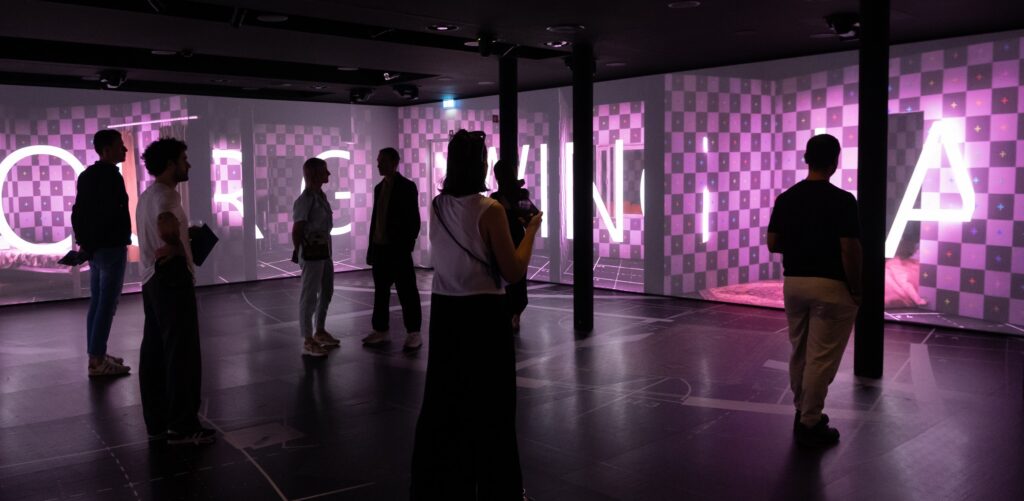Post
Intelligent Living. Interview with Gianluca Brugnoli

Talking about the future is exciting, but also exhausting.
Those who deal with the past, refine their thinking about what is written in history and news, tune in to their audience by focusing on the sequence of events, detect hidden details, give a new interpretation. Of course, this is not easy either.
Yet, talking about the future is even more complicated. It is difficult to tell about something that has yet to happen. The further we move away from our daily time horizon, the harder it is to be able to give a clear and vivid picture of what will be. It involves an effort to involve oneself in one’s vision of the future that is not easy to achieve.
Yes, of futures there are many. If the past has the relative advantage of a given certainty (what has happened is certain) the future brings with it all the unknown of unpredictability, and thus for those who deal with it, the possibility of being wrong, of going astray, increases.
This at MEET does not frighten. Those who work with us, those who follow us, know that it is precisely on the paths of the new and probable that our pace becomes sure, our vision sharper. We have probably grown accustomed to studying distant vistas.
Fortunately, we are not alone and we share this attitude with others who together with us courageously carry out this quest.
We had the opportunity to meet during the Salone del Mobile Gianluca Brugnoli, Chief Design Officer at the Huawei Milan Aesthetic Research Center who here at MEET opened the Tomorrow Living Exhibition the itinerary that saw the presentation of an incredible interweaving of thought made by thirty of the most important personalities from the world of design and architecture grappling with the idea of the future, habitability, resilience, safety in a framework that of the incredible.
Gianluca summarized the meaning of the project in his talk, but not content with that, we proposed he to explore other topics as well, to relaunch the discussion in an interview on mobility technology, city, and environment that we offer below.
Needless to say, we immediately got on the same wavelength, those who dream of futures gladly cross paths with others, and more voices, many voices, allow the vision of the new to have body and credibility, which is essential to be understood. And in explaining it, don’t overwork yourself.

MEET – The future of living is through digital, that is beyond doubt, but what is required for this to happen?
Gianluca – Digital is changing so many things in our world and our lives, because with digital, things are connected to the Internet and work because of software. So, the first requirement is that the spaces and objects around us are connected in a stable way to the network, so that they can exchange data and coordinate with each other. The sum of all these connections enables intelligent living, a continuous experience that goes beyond individual screens, individual devices, and individual spaces to become a “super-device,” enabling a continuous flow of digital experiences that connect physical and virtual worlds.
The second point is for the connection to be safe, secure, and private. This is central to enjoying the benefits of a truly connected life: trust. We must be sure that our privacy and identity are always protected. Today, security has become both a technological and a user experience issue. We see this well every day in the competition between various technology brands at the consumer level: the ability to ensure greater protection of data and privacy has become a critical factor of choice for users, who are increasingly sensitive and attentive to the issue. With the proliferation of connected devices that we can conveniently manage with a smartphone, we need to make security management stronger, easier, and more immediate to increase trust and adoption of the various technology solutions that enable intelligent living.
The third necessary condition is that the various devices connected to the home technology ecosystem are truly integrated and interconnected with each other at the software level and manageable with a good user experience, unified and simplified. This integration is critical both to enable true intelligent system automation that is not limited to individual device features but can combine features from different devices across various scenarios, and to provide a simpler and more efficient user experience for end-users. Today this is objectively a sore point, there is still too much fragmentation, and there is still a lot of work to be done to build a truly intelligent, unified, and integrated user experience.
MEET – Technology opens us up to a truly unprecedented aspect: artificial intelligence, voice interfaces, and digital holograms allow us to create an almost empathic interaction with objects. How will this change the way we live with such a deeply interactive and dialogic home?
Gianluca – Voice interfaces are a key step in intelligent living because they allow us to interact without a screen or keyboard. All it takes is a voice. At this point, I can be anywhere in a room or have my hands full, and still interact with a virtual assistant just by talking to it. With voice interaction, we can implement truly ubiquitous technology that is spread throughout the spaces around us.
New generations of voice interfaces work in both directions: we can talk to our connected devices, and they can talk back to us with their voices. Once this dialogue is open, the next step is to use sensors, data, and artificial intelligence to have a more sophisticated and empathetic interaction with technology that can understand our emotions and adapt the interaction accordingly. This is the new frontier for interaction designers.
There are already many examples where these forms of “artificial empathy” go so far as to almost anticipate needs and preferences, offering hyper-personalized experiences on the mood of the moment. We can have a virtual assistant that understands whether we need to rest or entertain ourselves and can adapt the atmosphere of our home accordingly by managing lights, sounds, temperature, and other devices. Or it will suggest how to adjust the temperature of a room, postpone the use of an appliance, to consume less energy without reducing comfort. In a world moving toward an aging population, we will be assisted in our homes by intelligent agents, robots that instead of just telling us our blood sugar reading or heart rate, may suggest what to eat for dinner or when to take medicine. So many interactions in our home today are handled manually one by one (opening or closing a window, adjusting the light or temperature, using an appliance), will be handled automatically in an intelligent way, following the context or need of the moment, even without our direct request.
However, these technologies will not replace interaction with other humans; that is not the purpose. Artificial empathy is a way to create increasingly personalized and simplified experiences, aggregating more functions in different scenarios and making interaction with various technological systems more natural and closer to our preferences, improving our quality of life.
MEET – New forms of living and mobility go hand in hand. At work in the change of the automobile is not only electrification, but integration into a broad set of innovations that affect the network, the territory, and also the habitability of its interior. How do you see its future?
Automotive is in the midst of a profound revolution. It is a double revolution, with both the shift from internal combustion engines to electric and the digital transformation of the vehicle. Many are focused on the first point, but the real disruption for the industry is the shift to digital. Already, cars are computers on wheels, run by software and hundreds of processors. The most innovative cars are increasingly like a smartphone: connected via the cloud, governed by increasingly sophisticated software, connected to digital services, with apps that install and update automatically. The digital shift also means increasing levels of “active safety,” to the point where there is talk of cars driving themselves with artificial intelligence (only under certain conditions).
The digitization of the automotive experience opens up several scenarios.
The first is that an always-connected car is a highly sophisticated IoT device fully integrated into our digital ecosystem. This means that my car, my smartphone, and my home are connected, use the same services and apps, and coordinate by exchanging data and information automatically in the background. In the car, I find my playlists, my messages, my apps, and content, and I can manage my destinations or scenarios in the home or office.
Second, a connected car that drives itself (almost) by itself is a lounge on wheels, a comfortable and cozy space where I can relax and do other activities. We will still have a driver in front of the wheel for a long time, but the experience inside the car will be increasingly personalized to individual passengers by combining entertainment and digital services, distinguishing for example children from adults. A nice example is NIO, a Chinese start-up that makes electric vehicles, in which one can interact by voice with almost every function of the car through Nomi, an intelligent virtual assistant that handles multiple scenarios, recognizing different users and addressing them differently.
Third, a connected car can be part of an integrated mobility system where private transportation, public transportation, parking spaces, charging spaces, and more are combined. The way of getting around in and out of the city can be rethought, with hyper-personalized car-sharing systems where each vehicle automatically adapts to my preferences and profile as a service user and already knows my destination or travel plan. These are all very fascinating scenarios and I think there is enormous potential for innovation and improvement.
MEET – Beyond the space of the housing and the space of mobility, also changing radically is the face of the city. The smart city concept has already entered the depths of our society, and it is talked about abundantly. What is less talked about is how smart cities will talk to the land? of the smart country is not discussed.
Gianluca – True, the digital divide also goes through the availability of broadband between city and country, and it is a global problem. Of course, large urban centers already concentrate on dozens of different technological systems and infrastructures and are naturally inclined to become interconnected and “smart.”
However, the experience of the past two years with remote working has put the limitations and bottlenecks from the current infrastructure into a new light and is challenging the idea of centralization. Distributed and de-centralized organizational models are beginning to be reevaluated. After all, digital is a mobile and ubiquitous technology by definition; services must reach anyone anywhere without physical or time restrictions.
To this scenario, I would add the major transformations already underway such as smart precision agriculture, Industry 4.0 projects, and the need to optimize and rationalize energy consumption by developing renewables, all of which require bandwidth, cloud services, AI, and IoT systems that are distributed and accessible everywhere. In my opinion, this will bring further attention to the availability of bandwidth on the ground outside large urban centers by developing investments and the deployment of communication networks.
Internet connectivity is no longer an option, and no longer just a technological issue: it is a social issue of participation in civic and communal life. To meet the future challenges on energy, environment, food, social, education, and jobs, we must realize the vision of Universal Broadband: everyone must have a quality, limitless connection available everywhere. And this is something governments can do.
